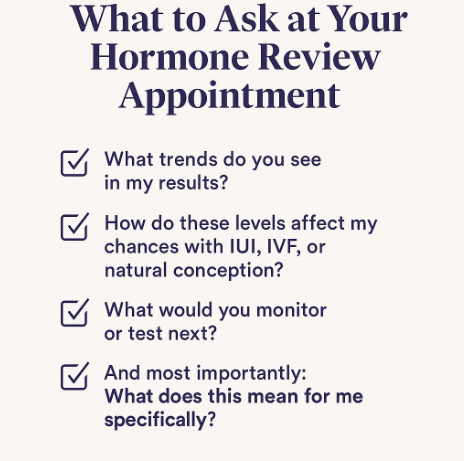Meet Your Fertility Hormones: What FSH, AMH & Progesterone Really Tell You
If you’ve recently had fertility bloodwork done or you’re preparing for testing you’ve probably seen a swirl of acronyms: FSH, AMH, LH, E2, progesterone… but what do they actually mean? And how do they relate to your ability to get pregnant?
Let’s break down the most important fertility hormones and how they guide your treatment plan.
Why Hormone Testing Matters
Your hormones are messengers, sending signals between your brain, ovaries, and uterus to coordinate everything from ovulation to implantation. Fertility hormone testing provides a snapshot of how well your reproductive system is functioning.
These labs often occur early in your cycle (typically days 2–5) and can help your fertility specialist:
- Evaluate ovarian reserve
- Diagnose potential causes of infertility (like PCOS or irregular ovulation)
- Customize your IVF or IUI treatment plan
What Each Hormone Tells You
Let’s decode the big four hormones commonly tested during a fertility workup:
1. FSH (Follicle-Stimulating Hormone)
What it does: Stimulates the ovaries to develop follicles (eggs).
When it's measured: Day 2–4 of your menstrual cycle.
What it tells us: Higher FSH levels may signal diminished ovarian reserve i.e a lower egg count, meaning the body is working harder to mature follicles.
Low FSH = better ovarian response. High FSH = potential concern for egg quantity and in possibly quality.
2. AMH (Anti-Müllerian Hormone)
What it does: Reflects the number of immature follicles left in the ovaries.
When it's measured: Anytime during your cycle.
What it tells us: Higher AMH suggests a larger ovarian reserve i.e more eggs. Lower AMH may suggest fewer available eggs.
AMH doesn’t predict pregnancy—it predicts how your ovaries may respond to stimulation.
3. Progesterone
What it does: Supports the uterine lining after ovulation and during early pregnancy.
When it's measured: About 7 days after ovulation (Day 21 in a 28-day cycle).
What it tells us: Low levels may indicate ovulation didn’t occur or wasn’t strong enough to support implantation.
Progesterone = the "nurturing" hormone after ovulation.
What’s “Normal” Varies And That’s Okay
A single lab value doesn’t determine your fertility. Age, cycle regularity, and personal history all affect hormone levels. That’s why interpreting results without context often leads to unnecessary panic.
A good clinic won’t just read your numbers—they’ll understand your full picture and build a plan around it.

💜 Aspire Fertility Helps You Read Between the Numbers
At Aspire Fertility, our goal is to simplify the science so you can feel confident in every step forward. We take time to explain your hormone results, translate your options, and tailor a plan based on your body—not a generic chart.
👉 schedule a consultation and take the guesswork out of your next move.


















